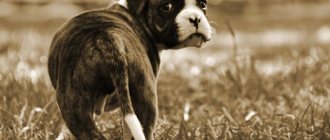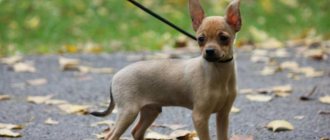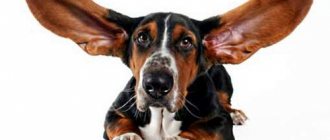The question of why a dog needs a tail seems idle and even funny. However, studying this topic allows you to gain a deeper understanding of the dog’s body and how it functions. For a dog, a tail is both a way of communication with the outside world, a way of maintaining balance, and a way of controlling the secretory glands. Moreover, each breed has its own tail shape - dropped, curled or laid back. We will talk further about how the tail helps a dog in life and the dangers of docking it.
Why does a dog need a tail?
Tail like a rudder
In a sense, the tail can be compared to human arms, which we often swing when walking. If you try to start moving your hands artificially or stop them artificially, you create a feeling of stiffness and awkwardness. Roughly the same thing happens in dogs, since the tail is responsible for balancing and correct positioning of the body in space during particularly difficult moments. Such moments may include walking on a log or other uneven surface.
The tail helps dogs maintain balance
The tail is also a reliable assistant for the dog while swimming. Even with the naked eye you can see that the “mermaid” breeds, which assumed frequent contact with water, have a long and expressive tail. It allows you to remove a certain load from the paws and intelligently redistribute it, allowing the dog to swim longer distances. The following dog breeds are considered “aquatic”:
- Wetterhaun;
- Newfoundland;
- Irish Water Spaniel;
- American Water Spaniel;
- Portuguese Water Dog;
- Spanish water dog
- Lagotto Romagnolo.
The tail helps the dog stay afloat
By the way! In addition to a powerful tail, aquatic individuals are distinguished by fluffy, curly hair, most often having an impressive length, in which its owners literally drown.
Animal balancing tool
The tail is one of the important parts of a dog's body. It is a continuation of the spine, so any injuries to the tail will negatively affect the health of the entire body. With active movement while running and walking, the dog helps itself to choose a more accurate direction. Therefore, the tail is the dog's main balancing tool.
In addition, when swimming, it helps to swim a long distance, relieving the load from the dog’s paws. If the tail in the water is perpendicular to the body, the pet will be able to feel more stable and lighter in the water.
Tail as an odor blocker
In order to deepen the understanding of this important function, it is necessary to first explain such a physiological detail as the paraanal glands. Many owners do not even have an idea about these glands, since it is very difficult for someone inexperienced in zoology to recognize their influence on the dog’s life.
The paraanal glands require periodic care to avoid inflammation.
Externally, the paraanal glands resemble small sacs that are located at the exit from the anus of the animal. Over time, the bags are filled with a specific secretion, which is capable of emitting its own individual smell. This smell is an element of a complex system of interaction between dogs.
Functions of the paraanal glands
The paraanal glands acquire the greatest importance during the period of sexual readiness, since they perform the following two important functions:
- notify the hypothetical sexual partner that the individual is ready to mate;
- notify the animal’s rivals about its plans for a partner and its readiness to fight.
The anal glands are an important tool in canine communication.
The smell emanating from the secretion can either actively spread or be drowned out - it all depends on the dog’s intentions and mood. By actively waving its tail, the animal uses it as a fan, thanks to which the smell of the secretion spreads faster, thereby spreading information about the presence of the dog. If a dog does not want to be recognized and participate in any communication with its relatives, it deliberately presses its tail to hide its presence.
As a rule, acquaintance with the paraanal glands occurs when they become inflamed in a dog and require treatment. You can read below about how to avoid this painful phenomenon for your dog and learn how to flush these glands.
Cleaning the dog's anal glands
What do we have in common with our four-legged friends?
For each type of animal, the tail performs its own functions. In kangaroos it is a support when jumping. Cows need a tail to escape annoying insects.
Maybe it will even be news to someone that we humans also have a tail. No, not among those primitive ape-men, but precisely among us, the modern inhabitants of the Earth. Yes, yes, at an early stage of its development, the human embryo boasts a small tail, which grows when the spine is formed. This tail subsequently stops developing and turns into a tailbone. Therefore, it is worth noting that it turns out that we and our four-legged friends have a lot in common.
Why does a dog chase its tail?
Sometimes pet owners witness such a funny and at the same time mysterious phenomenon as a dog trying to catch up and grab its own tail. The reasons for such an action can lie in both behavioral and pathological spheres, therefore the context in which the dog begins to behave in a similar way is important.
The dog's attempts to grab its tail end in prolonged dizziness
Among the most common reasons why animals begin to chase their tail, we will focus on the main ones:
- showing interest in your body;
- need for attention from the owner;
- mental disorder;
- panic attacks;
- dysfunction of the vestibular apparatus;
- unsuccessful tail docking.
Showing interest in your body
This interest is most often found in puppies, who are generally distinguished by their curiosity. However, it is worth noting that normally this behavior has its own time frame. The baby quickly recognizes the tail as an integral part of his body and stops paying attention to it.
It is normal for puppies to show interest in their tail.
Need for attention
Through such unusual behavior, the animal sometimes sets itself the goal of attracting the attention of its owner (even regardless of whether the final reaction is positive or negative). In addition to the stereotypical tail chasing, a dog experiencing a lack of attention from its owner may exhibit other behavioral characteristics:
- hiding the owner's belongings;
- emptying the bowel or bladder in the wrong place;
- long and causeless barking.
Strange dog behavior may be a sign of boredom or a desire to be noticed by the owner.
Mental disorder
A mentally unstable dog may perceive the world around it and its body in a distorted way, recognizing the tail as a hostile living creature. Unlike puppy interest, this behavior is accompanied by pronounced aggression - the dog wants not only to catch up, but to bite and harm his “enemy.” If this symptom is detected, it is necessary to show the animal to a doctor.
Obsessively chasing its tail may indicate the presence of mental pathologies in a dog
Panic attacks
Unlike mental disorders, panic attacks may have nothing to do with disturbances in the central nervous system or other serious problems. Chasing the tail in such situations becomes a way to relieve stress and unnecessary tension that can be caused by any unpleasant events for the dog.
The following symptoms help recognize a panic attack:
- whining;
- increased salivation;
- random movement around the house;
- attempts to hide or run away from home;
- increased breathing.
Video - Panic attack in a dog
Vestibular syndrome
Circular movements, which normally cause dizziness, are forced for dogs that experience serious changes in the functioning of the vestibular apparatus. One possible cause of such changes is traumatic brain injury. In addition to injuries, poor coordination can also be caused by glycemia (which is especially typical for dogs with diabetes), as well as by certain pathologies in the liver.
In addition to chasing the tail, dogs with disorders of the vestibular system also experience coordination problems.
Failed tail docking
Unfortunately, not all operations of this type are carried out successfully and in some cases dogs are forced to get used to fragments of a severed vertebra, which cause discomfort to the animal. In addition to fragments, the surgeon may simply leave an insufficient amount of connective tissue, which will also lead to injuries and the dog’s attempts to lick its wounds.
An improperly docked tail will cause constant irritation to the dog.
Physiological features and types
Physiologically, the tail consists of several vertebrae, since it is a continuation of the spine. Depending on the breed of the animal, the shape and length of the appendage changes. Indicators vary depending on the area of origin of the animal, as well as its purpose. There are several types of appendages:
- The log is straight, elongated, round. The dogs got it from the wolf. It is currently found rarely and mainly in Labradors and St. Bernards.
- Saber-shaped - in a calm state, lowered and slightly curved, resembling a saber in appearance. The owners are German shepherds and collies.
- The hook is lowered in a calm state with a fairly strongly bent end. South Russian and Caucasian shepherd dogs have it.
- Crescent - curved over the back, but does not lie on it. Huskies and Spitz dogs are endowed with a similar feature.
- The ring is completely curved and lies on the back of the animal. Owners: Huskies, Malamutes, Siberian Huskies.
Interesting information! In some breeds, the tail may have two curls, a spiral shape and a corkscrew shape. Hunters have their own terminology for the names of types of appendages in dogs.
Tail docking
The docking procedure involves surgically removing part of a dog's tail. As a rule, this operation is performed on puppies, since they tolerate it most easily. The older the dog gets, the more difficult it is for her to cope with the absence of a tail and get used to a new way of life. The physiological side of the issue also has an effect - the wound after surgery in adults takes longer to heal than in cubs.
Tail docking using drag
Historical excursion
Tail docking for dogs is a very ancient practice, the first mentions of which go back to the times of Ancient Rome. During that era, docking was considered a preventative measure to protect dogs from rabies (as people believed at the time). Other reasons for tail removal in dogs in subsequent years were the following:
- safety of hunting dogs while chasing wild animals. It is logical that the dog’s long tail is easy to grab, thereby significantly reducing its chances of survival. No tail means no problem;
Hunting dogs had their tails removed to preserve the animal's life
- tax exemption. Several centuries ago, dog owners in England paid a tax for their dogs. Only hunting and service dogs (that is, dogs with docked tails) were not subject to this rule. However, it was also possible to evade the tax by a small trick - removing the tail of an individual that had nothing to do with hunting;
- the practice gradually turned into habit until it became a “canon” for a number of breeds, included in the standard and required of dogs participating in exhibitions.
For some dog breeds, tail docking is a requirement for participation in shows.
Our days
At the moment, docking is prohibited in a number of European countries. The exception is dogs that are involved in the following organizations:
- government law enforcement agencies;
- armed forces;
- rescue services;
- services responsible for removing rats and other rodents.
Tail docking before and after
That is, tail removal is permitted only in cases where it is due to the main occupation of the animal and serves to preserve its health. However, even such individuals must undergo a docking procedure according to strict rules:
- Only a qualified veterinarian can perform surgical intervention;
- docking should take place in the first five days of the calf's life.
Age restrictions
Despite the existence of the Animal Law, the points of which we discussed above, its requirements are not met in all countries. In this regard, docking continues to be practiced both in the first days after birth and after the dog reaches maturity. You can read about how tail docking occurs in puppies at different ages in the table.
Table 1. Tail docking in puppies of different ages
| Age | Features of the operation |
| Three to ten days | This age is optimal for the operation, since in newborn puppies the wounds heal quickly enough and are least painful. Due to the fact that the tail vertebrae have not had time to ossify, tail removal is not accompanied by sutures. The reduced pain threshold also allows you to do without the use of anesthesia. During the healing period, puppies are not allowed near their mother, as there is a possibility that she will begin to lick the wound, thereby lengthening the healing time and increasing the risk of infection. |
| Ten to twenty days | Starting from the age of ten days, the threshold of sensitivity in puppies rises, which leads to the need to use anesthesia, which affects the baby’s body. Otherwise, the operation is carried out in a similar way - the puppy’s tail is cut off without applying tourniquets, since the vertebra is still quite soft and heals quickly |
| From twenty days to a month | One-month-old puppies have their tail removed under general anesthesia, and the operation is performed with the obligatory application of a tourniquet to the base of the tail. Tail docking is the most difficult for older puppies, so veterinarians strongly advise against delaying this procedure. |
It is believed that puppies tolerate amputation the easiest
Cons of tail docking
A very natural question would be why animal rights activists are so actively in favor of banning tail docking on dogs. The fact is that while providing the animal’s safety in a number of cases, tail removal is still a gross intervention in the dog’s physiology, leading to a number of complications in the individual. Such complications include the following:
- weakening of motor skills;
- pathologies of urinary functions;
- the appearance of intervertebral hernias;
- deformation of the fingers of the hind limbs;
- problems in establishing relationships with other relatives;
- behavioral disorders (increased level of aggression).
Dogs with docked tails may later develop various motor and genitourinary complications.
Of course, one dog does not account for the entire list of possible violations given above. It also happens that individuals with docked tails live a long and prosperous life as a healthy dog. However, this scenario is not always realized, because tail docking can have a negative impact on both a physiological and psychological level.
Psychological aspect
As mentioned earlier, the tail is one of the dog's main means of communication. Therefore, a dog with a missing tail is in a certain isolation from its surrounding relatives. Other dogs are wary of the “stranger” because they cannot determine his mood and approximate plans.
Dogs that have not found a common language with their relatives can become depressed and need support.
Being social animals, dogs with docked tails have a hard time being an outcast. Largely for this reason, docking causes an increase in aggression in the animal. Therefore, a dog with a tail removed needs a caring and understanding owner who can compensate for the lack of full interaction with other dogs.











